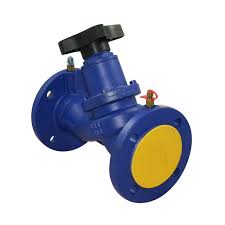Exploring the Electronic Variable Orifice
In the realm of fluid control and regulation, the electronic variable orifice stands out as a sophisticated and versatile component. This innovative technology offers precise control over fluid flow rates, making it a valuable asset in various industrial applications.
At its core, an electronic variable orifice is designed to adjust the opening size through which fluid passes. This adjustment is typically achieved through electronic signals that control the orifice’s aperture, allowing for accurate and real-time flow rate modulation.
One of the key advantages of an electronic variable orifice is its ability to provide dynamic control over fluid flow. By adjusting the orifice size based on changing operational requirements, this technology enables efficient and responsive system performance.
Furthermore, electronic variable orifices offer enhanced precision compared to traditional manual valves or fixed-size orifices. This level of control not only improves process efficiency but also contributes to cost savings by reducing waste and optimizing resource usage.
Applications of electronic variable orifices span across various industries, including automotive, aerospace, pharmaceuticals, and more. Whether used for flow regulation in hydraulic systems, fuel injection in engines, or pressure control in pneumatic systems, this technology plays a crucial role in enhancing operational efficiency and performance.
In conclusion, the electronic variable orifice represents a cutting-edge solution for fluid flow control, offering precision, flexibility, and efficiency in diverse industrial settings. As technology continues to advance, we can expect further innovations and refinements in this essential component that drives optimal performance and productivity.
Top 6 Tips for Optimising Your Electronic Variable Orifice System
- Ensure proper installation and calibration of the electronic variable orifice to optimize performance.
- Regularly check for any leaks or blockages in the system to maintain efficiency.
- Follow manufacturer’s guidelines for maintenance schedules and procedures.
- Monitor pressure and flow rates to ensure the electronic variable orifice is operating within specified parameters.
- Train personnel on how to operate and troubleshoot the electronic variable orifice system effectively.
- Consider integrating smart technology for remote monitoring and control of the electronic variable orifice.
Ensure proper installation and calibration of the electronic variable orifice to optimize performance.
To maximise the performance of an electronic variable orifice, it is crucial to ensure its proper installation and calibration. By following precise installation procedures and accurately calibrating the orifice, you can optimise its functionality and efficiency. Proper installation guarantees that the orifice operates smoothly within the system, while calibration ensures that it accurately regulates fluid flow rates according to specific requirements. Taking the time to set up and calibrate the electronic variable orifice correctly will result in enhanced performance, increased reliability, and prolonged lifespan of this essential component in fluid control systems.
Regularly check for any leaks or blockages in the system to maintain efficiency.
To ensure optimal performance and efficiency when using an electronic variable orifice, it is crucial to regularly inspect the system for any potential leaks or blockages. By conducting routine checks, you can identify and address issues promptly, preventing disruptions to fluid flow and maintaining the overall effectiveness of the orifice. Proactive maintenance not only helps in preserving the functionality of the system but also contributes to prolonging the lifespan of the electronic variable orifice, ensuring consistent and reliable operation in various industrial applications.
Follow manufacturer’s guidelines for maintenance schedules and procedures.
When it comes to electronic variable orifices, it is crucial to adhere to the manufacturer’s guidelines for maintenance schedules and procedures. Following the recommended maintenance practices ensures the optimal performance and longevity of the orifice. By staying proactive and conducting regular maintenance as per the manufacturer’s instructions, you can prevent potential issues, maintain efficiency, and prolong the lifespan of this critical component in fluid control systems. Trusting in the manufacturer’s expertise and guidelines is key to maximising the reliability and functionality of electronic variable orifices.
Monitor pressure and flow rates to ensure the electronic variable orifice is operating within specified parameters.
To ensure optimal performance of an electronic variable orifice, it is essential to monitor pressure and flow rates regularly. By keeping a close eye on these key parameters, operators can verify that the orifice is operating within the specified limits. Monitoring pressure and flow rates not only helps maintain the efficiency of the system but also prevents potential issues that may arise from operating outside the designated parameters. This proactive approach to monitoring ensures smooth operation and maximises the benefits of using an electronic variable orifice in industrial applications.
Train personnel on how to operate and troubleshoot the electronic variable orifice system effectively.
To maximise the benefits of an electronic variable orifice system, it is essential to train personnel on how to operate and troubleshoot the system effectively. Providing comprehensive training ensures that operators have the knowledge and skills to optimise the performance of the electronic variable orifice, leading to improved efficiency and reduced downtime. By equipping personnel with the necessary expertise, organisations can enhance system reliability, identify and resolve issues promptly, and ultimately achieve smooth operation of the electronic variable orifice system.
Consider integrating smart technology for remote monitoring and control of the electronic variable orifice.
When utilising electronic variable orifice technology, it is advisable to explore the integration of smart technology for remote monitoring and control. By incorporating smart features, such as remote access and monitoring capabilities, users can efficiently oversee and adjust the electronic variable orifice’s performance from a distance. This not only enhances convenience but also enables proactive maintenance and optimisation of fluid flow processes, ultimately improving operational efficiency and productivity.
Tags: aerospace industry, automotive industry, cost savings, dynamic control, efficiency, electronic variable orifice, flow rates, flow regulation, fluid control, fuel injection systems, hydraulic systems, industrial applications, operational requirements, pharmaceutical industry, precision, pressure control systems, regulation, resource usage, system performance, technology
